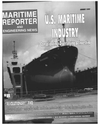
Page 25: of Maritime Reporter Magazine (August 1997)
Read this page in Pdf, Flash or Html5 edition of August 1997 Maritime Reporter Magazine
U.S. Maritime Review
The U.S. shipbuilding industry is as diverse as the country itself. It is still dominated by the "Big Six" and the billions of dollars worth of Navy work these yards garner, but the industry has been very chameleon-like in the past few years, constantly changing and re-inventing itself to take advantage of the market at- hand or the market to come.
While the big shipyards gen- erate most of the 72-point head- lines, the second tier yards are perhaps enjoying greater suc- cess overall, as several renowned builders have suc- cessfully positioned themselves in order to capture business at home and abroad.
Without a doubt change is the constant in today's downsizing, consolidating business environ- ment, and the common thread which unites this diverse group is a strong commitment to improving the processes and equipment to build modern ships and boats efficiently, to a world standard of quality and price.
Powered with political back- ing, specifically the Maritime
Administration's (MarAd) revamped, re-energized Title XI program, ship and boat- builders have been encouraged to invest dollars to make these changes a lasting reality.
Not only has Title XI allowed ship and boatbuilders to invest in new systems, it has helped deliver the business which is crucial to maximizing these new efficiencies. In all of FY96 and the first half of FY97,
MarAd approved 23 applica- tions for Title XI financing, including four export projects and three shipyard moderniza- tion projects. The total esti- mated cost of these projects is $1.7 billion, with the govern- ment vouching for $1.3 billion.
All momentum driving the
U.S. market has not been
MarAd-induced however, as the surging offshore business has driven most Gulf Coast yards into a controlled frenzy.
Reports of builders with full orderbooks and labor shortages are a welcome change after the oilfield collapse in the early 1980s left so many with dam- aged psyches and little, if any, business.
OPA 90 continues to leave its mark as well, and this legisla- tion, combined with a three- year run of improving grain freight rates, have made mas-
Alabama Shipyard: Aerial photo shows the first chemi- cal tanker for Dannebrog
Rederi nearing completion afloat, and the second tanker under construction at the erection site. sive barge building projects the norm, attracting some larger players to the game. It is antic- ipated that the surge in new barge orders will continue, as inland operators still have about 500 single-skinned barges that must be replaced.
The U.S. orderbook is healthi- er than in recent memory, a fact emphasized by the ever-grow- ing size of the quarterly
Shipyard Activity Report pub- lished by MarAd. The following section details some notable projects currently running in
U.S. yards:
Atlantic International Ltd. has entrusted Service Marine
Industries (SMI) with the con- version and refurbishment of
Louis Eymard. Once a supply vessel used for towing, the ves- sel will be cut in half and extended 20 ft. (6 m) with the addition of a midbody section,
The HLX2225 from Halter Marine Group is a 225-ft. (68.5-m) anchor handling/tug supply
With a 30-ft. (9-m) beam, four V-12 KTA 38
Cummins engines easily fit across Paula Kay's engine room. Diamond Services put the 170-ft. (51.8-m), Hamilton jet-powered boat into service in Gulf of Mexico offshore oilfields in June. (photo credit: Skeets Photo)
August, 1997 25

 24
24

 26
26
